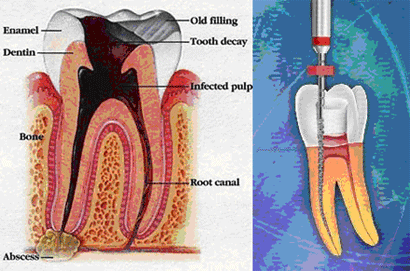| |
 |
|
|
 Root Canal Treatment explanation
Root Canal Treatment explanation |
| |
Endodontics is the branch of dentistry
that deals with diseases of the tooth's pulp. The pulp is found
in the center
of the tooth and in canals (called root canals) inside the root
of each tooth. Pulp includes connective tissue, nerves and blood
vessels. Pulp nourishes the tooth when it first emerges through
the gum. Once the tooth matures, the pulp can be removed without
destroying the tooth. That's because each tooth also is nourished
by a blood supply in the gums.
Removing the pulp is called endodontic treatment, but it is often
referred to as root canal treatment or root canal therapy. Many
people refer to pulp removal as "having a root canal." Root canal
treatments are quite common. In the United States, they save about
24 million teeth each year. |
| |
 Why Would You Need Root Canal Treatment?
Why Would You Need Root Canal Treatment? |
| |
Root canal treatment is needed for two
main reasons. The first is infection. An untreated
cavity is a common cause of pulp infection. The decay erodes
the enamel and dentin of the tooth until it reaches a root canal.
This allows bacteria to infect the pulp. Antibiotics can't get to
infections inside teeth. The inflammation caused by the infection
reduces the blood supply to the tooth. The reduced blood supply
also keeps the pulp from healing.
The second reason for a root canal is damage to the pulp that can't
be fixed. Trauma or a fractured tooth can damage the pulp. So can
a lot of restoration, such as several fillings
placed in the same tooth over a period of time. Sometimes, common
dental procedures, such as preparing a tooth for a crown,
can hurt the pulp. Then the tooth might need a root canal.
An infection in the pulp can affect the bone around the tooth. This
can cause an abscess
to form. The goal of root canal treatment is to save the tooth by
removing the infected or damaged pulp, treating any infection, and
filling the empty root canals with a material called gutta percha.
If root canal treatment is not done, an infected tooth may have
to be extracted. It is better to keep your natural teeth if you
can. If a tooth is missing, neighboring teeth can drift out of line.
They also can be overstressed from chewing. Keeping your natural
teeth also helps you to avoid other treatments, such as implants
or bridges. Also, if you ignore an infected or injured tooth the
infection can spread to other parts of your body.
Having root canal treatment on a tooth does not mean that the tooth
will need to be pulled out in a few years. Once a tooth is treated,
it almost always will last the rest of your life. |
| |
 Signs and Symptoms Signs and Symptoms |
| |
| If you have an infection of the pulp,
you may not feel any pain at first. But if it is not treated, the
infection will cause pain and swelling. In some cases, an abscess
will form. |
| |
| Your tooth might need a root canal if:
|
| |
 It hurts when you bite down on it, touch it or push on it
It hurts when you bite down on it, touch it or push on it
 It is sensitive
to heat It is sensitive
to heat
 There is swelling near the tooth
There is swelling near the tooth
 It is discolored (whether it hurts or not)
It is discolored (whether it hurts or not)
 It is broken
It is broken
|
| |
 |
| |
| [
Back to Endodontics ] |
| |
|
|
|  |
|
| © All
rights reserved. Since 2013 Pro Dental NC |
|
|